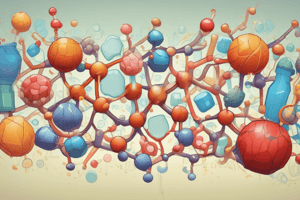Podcast
Questions and Answers
What type of linkage connects alpha-glucose to form side branches in polysaccharides?
What type of linkage connects alpha-glucose to form side branches in polysaccharides?
- 1-6 glycosidic linkages (correct)
- 1-2 glycosidic linkages
- 1-3 glycosidic linkages
- 1-4 glycosidic linkages
All lipids are polar molecules.
All lipids are polar molecules.
False (B)
What is the primary function of cellulose in plants?
What is the primary function of cellulose in plants?
providing structural support
The sugar found in milk is called __________.
The sugar found in milk is called __________.
Match the following lipid types with their characteristics:
Match the following lipid types with their characteristics:
What is the formula for monosaccharides?
What is the formula for monosaccharides?
Disaccharides are generally sweeter than monosaccharides.
Disaccharides are generally sweeter than monosaccharides.
What is the primary function of monosaccharides in biological systems?
What is the primary function of monosaccharides in biological systems?
A covalent bond that forms between two monosaccharides is known as a __________ bond.
A covalent bond that forms between two monosaccharides is known as a __________ bond.
Match the types of carbohydrates with their descriptions:
Match the types of carbohydrates with their descriptions:
Flashcards are hidden until you start studying
Study Notes
Carbohydrates Overview
- Composed of carbon, hydrogen, and oxygen.
- Monosaccharides (simple sugars) have a 1:2:1 atom ratio; formula: (CH2O)n.
- Characteristically sweet-tasting and often identified by names ending in -ose.
- Functional groups present: Carbonyl (aldehyde or ketone) and hydroxyl groups enhance solubility.
Functions of Carbohydrates
- Serve as energy sources.
- Provide structural support.
- Facilitate cell-to-cell communication.
- Raw materials for building amino acids, lipids, and nucleic acids.
- Functionality is linked to the carbohydrate's structural makeup.
Isomers
- Isomers possess the same chemical formula but differ in atom arrangement leading to varied chemical properties.
Types of Carbohydrates
- Monosaccharides: Single sugar unit, simplest form; include glucose (widely used), and can be triose, pentose, or hexose.
- Disaccharides: Formed by two sugar subunits; examples include sucrose (table sugar) and lactose (milk sugar).
- Polysaccharides: Complex carbohydrates consisting of many monosaccharides; variations in structure based on glycosidic linkages.
Monosaccharides
- The sweetest sugars, with glucose being the most common.
- Exist in linear or ring forms, especially in water.
- Functions: short-term energy storage (e.g., glucose) and building blocks for nucleic acids (e.g., ribose, deoxyribose).
- Linked by glycosidic bonds between carbon atoms.
Disaccharides
- Generally used for short-term energy storage.
- Less sweet than monosaccharides due to more subunit linkages.
- Examples: maltose (used in brewing), sucrose (sweetener), lactose (milk sugar).
Polysaccharides
- Highly varied 3D structure, composed of numerous monosaccharides.
- Water solubility is low due to their large size, despite polar functional groups.
- Polymerization:
- Alpha-glucose forms linear chains through 1-4 glycosidic linkages; side branches through 1-6 linkages.
- Beta-glucose requires flipping for proper chain packing.
Functions of Polysaccharides
- In Plants: Long-term energy storage (amylose, amylopectin), structural support (cellulose).
- In Fungi: Structural support through chitin.
- In Animals: Long-term energy storage and structural support (exoskeletons in insects/crustaceans).
Lipids Overview
- Characteristically amphiphilic, containing both hydrophilic and hydrophobic regions.
- Composed mainly of carbon and hydrogen; largely non-polar.
- Structurally based on fatty acids, classified into 5 classes: fatty acids, fats/oils, phospholipids, steroids, and waxes.
Fatty Acids
- Structural traits: Hydrocarbon chain (4+ carbons) with a carboxyl group at one end, rendering acidic properties.
- Types of fatty acids:
- Saturated: No double bonds, linear shape, tightly packed, solid at room temperature.
- Unsaturated: Presence of double bonds, causing kinks in the chain, resulting in looser arrangement, generally liquid at room temperature.
Studying That Suits You
Use AI to generate personalized quizzes and flashcards to suit your learning preferences.




